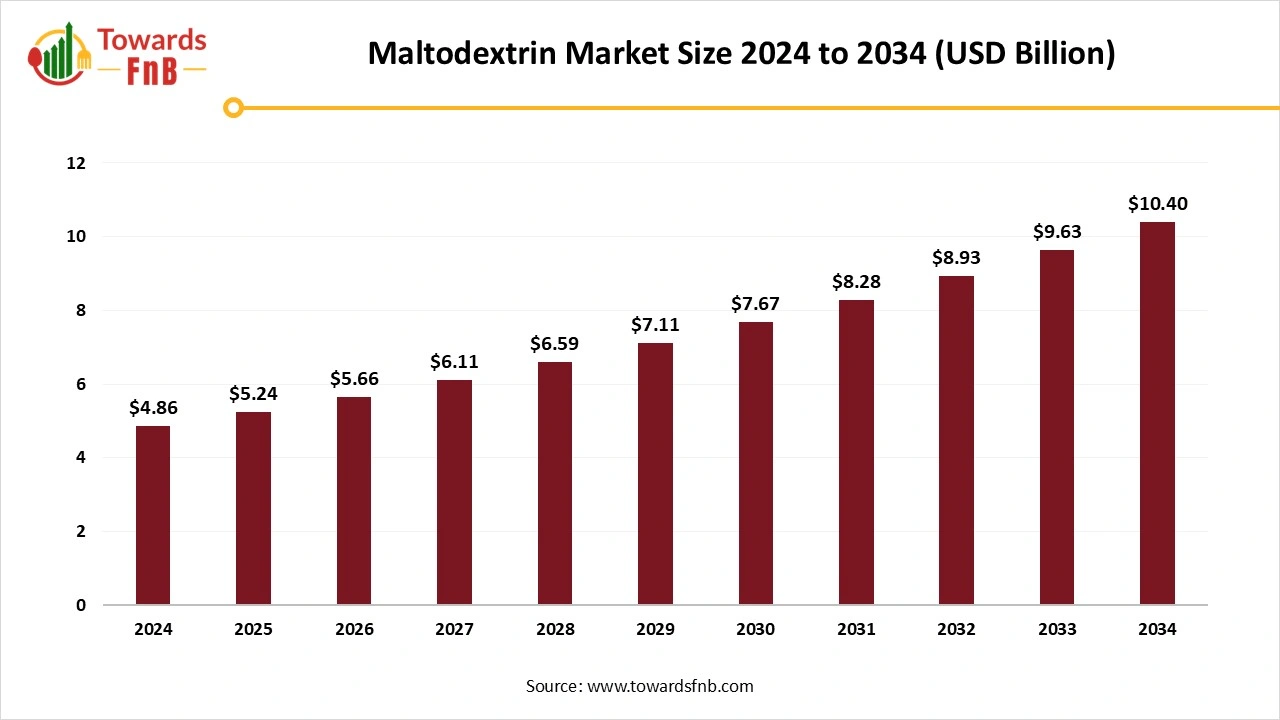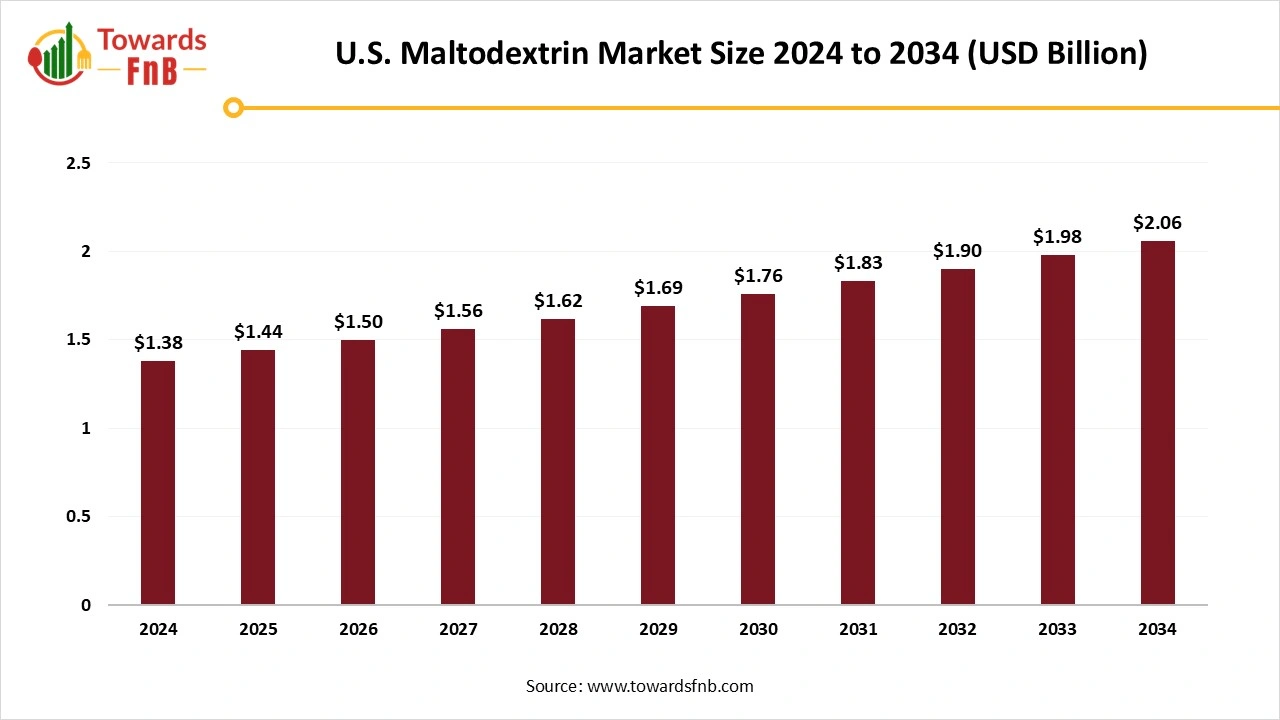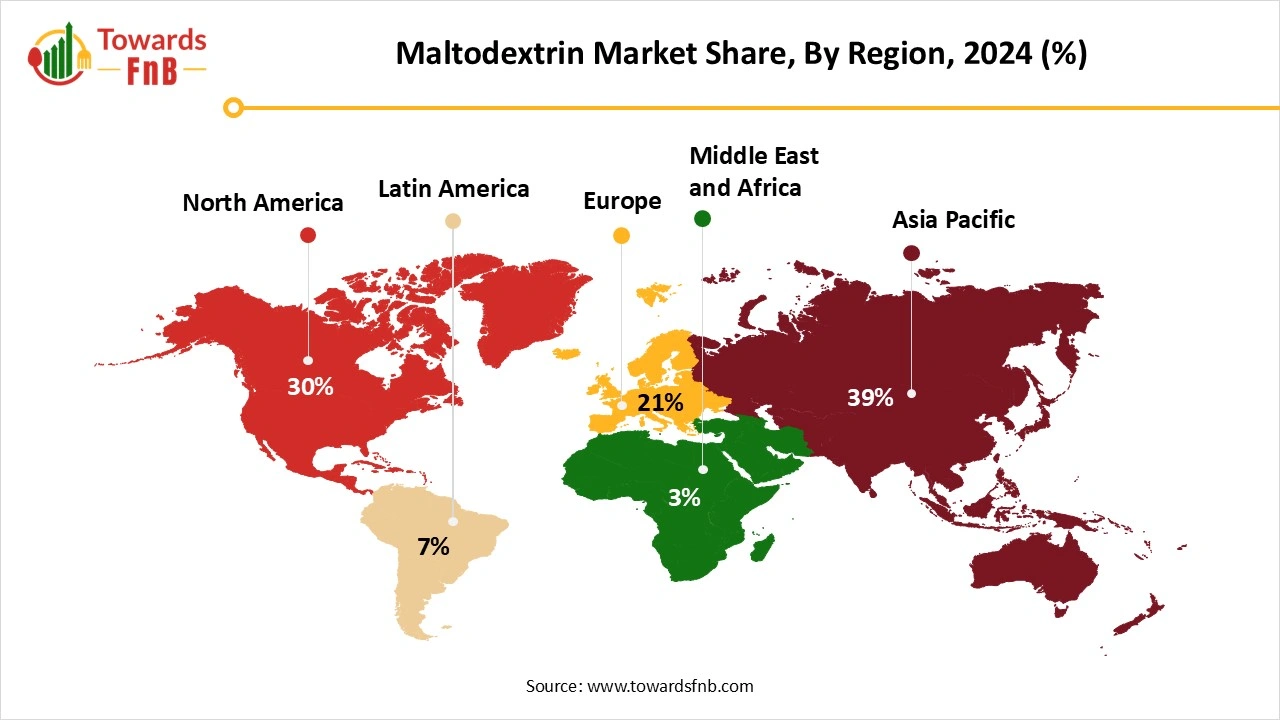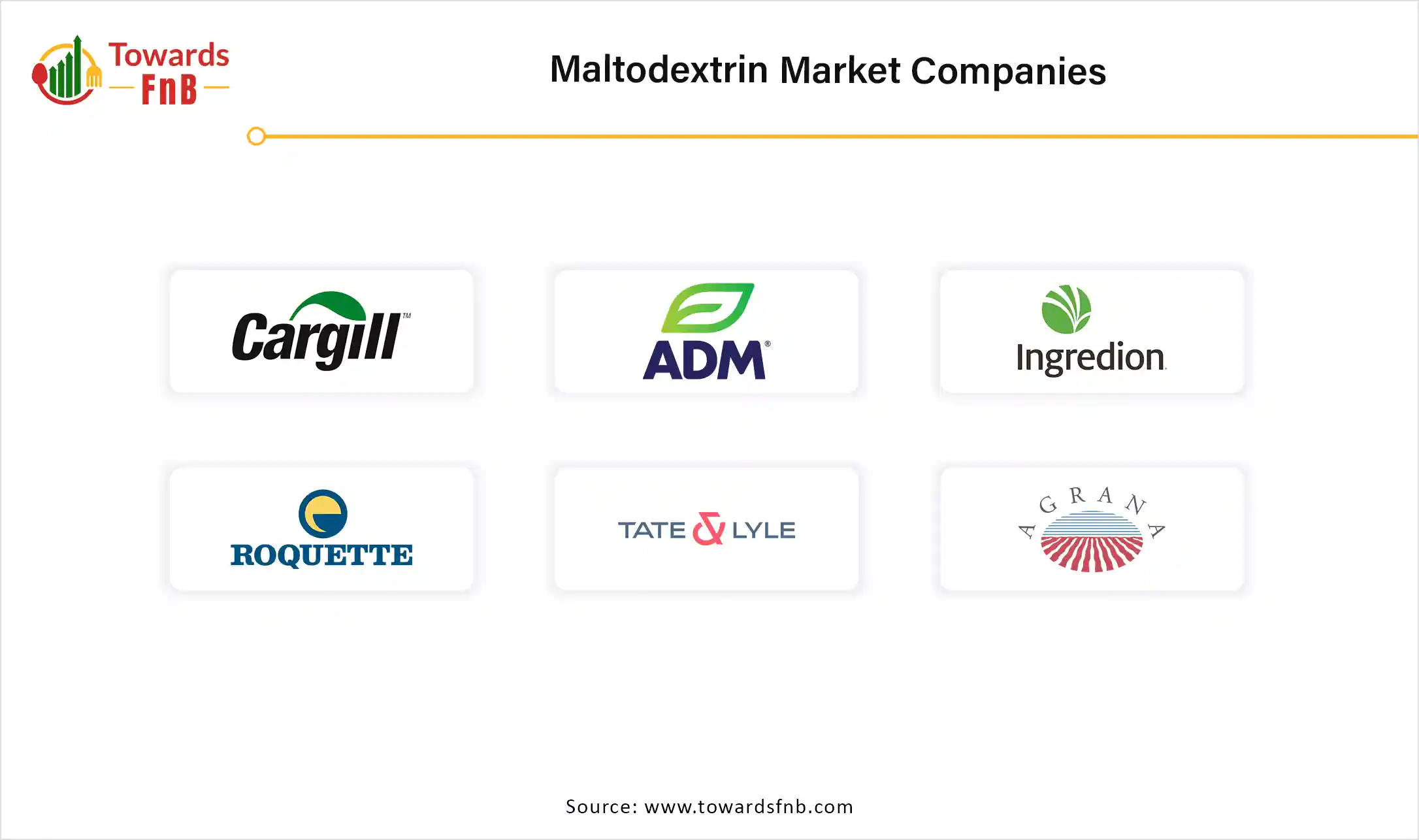November 2025
The global maltodextrin market size was calculated at USD 4.86 billion in 2024 and is expected to rise from USD 5.24 billion in 2025 to nearly reaching USD 10.40 billion by 2034, growing at a CAGR of 7.9% during the forecast period from 2025 to 2034. Maltodextrin formulations offer enhanced energy levels, improved texture, and stabilizing formulations to potential global consumers.

| Study Coverage | Details |
| Growth Rate from 2025 to 2034 | CAGR of 7.9% |
| Market Size in 2025 | USD 5.24 Billion |
| Market Size in 2026 | USD 5.66 Billion |
| Market Size by 2034 | USD 10.40 Billion |
| Largest Market | Asia Pacific |
| Base Year | 2024 |
| Forecast Period | 2025 to 2034 |
| Regions Covered | North America, Europe, Asia-Pacific, Latin America, and Middle East & Africa |
The maltodextrin market refers to the global industry focused on the production, distribution, and utilization of maltodextrin a white, powdery polysaccharide derived from starch (typically corn, wheat, rice, or potato). Maltodextrin is widely used as a thickener, filler, carrier, stabilizer, and bulking agent in a variety of food, beverage, pharmaceutical, and industrial products. It is characterized by a dextrose equivalent (DE) of less than 20, offering mild sweetness and excellent solubility. Its affordability, neutral taste, and versatile functionality have made it a key ingredient in processed and functional food formulations.
Maltodextrin has various applications, including convenience foods, sports drinks, and packaged foods. It can be used in the pharmaceutical industries in various food and beverage preparations. Maltodextrin is generally recognized as safe (GRS) by the Food and Drug Administration (FDA).
Climate change causes instability in raw materials and pricing burden. The global logistics challenges and geopolitical tensions also pose pricing challenges. The production costs, health concerns, and technological adoption also present dynamic challenges across the maltodextrin market.
U.S. Maltodextrin Market Size and Growth 2025 to 2034
The U.S. maltodextrin market was valued at USD 1.38 billion in 2024, with projections indicating growth to USD 1.44 billion in 2025 and reaching approximately USD 2.06 billion by 2034. The market is expected to expand at a CAGR of 4.1% during the forecast period from 2025 to 2034. Key drivers of this growth include the increasing demand from the food & beverage, pharmaceutical, and cosmetics industries, as well as the rising consumer preference for organic, gluten-free, and functional ingredients.

The U.S. maltodextrin market is expected to experience steady growth in the coming years, driven by increasing demand across industries such as food and beverages, pharmaceuticals, and cosmetics. The rise in consumer interest for organic, gluten-free, and functional ingredients is also contributing to the market's expansion. This trend is projected to continue as the market evolves, with a positive outlook for the foreseeable future.
How Asia Pacific Dominated the Maltodextrin Market in 2024?
Asia Pacific dominated the maltodextrin market with an estimated market share of ~39% in 2024. According to the Food and Agriculture Organization of the United Nations, the Asian Pacific countries will explore innovative technologies to fight against hunger and malnutrition in September 2024. The National Library of Medicine and the National Center for Biotechnology Information conducted a study on the effect of diabetes-specific nutrition formula. In January 2025, Healthy Eating Research published a report on healthy beverage consumption in school-age children and adolescents. It has provided recommendations from major national health and nutrition organizations.

How does India Contribute Majorly to the Food Ecosystem and Food Safety?
The various policymakers, educational institutions, workplaces, food businesses, and consumers play a key role in food safety. The Food Safety and Standards Authority of India (FSSAI) uses various mediums and tools towards eating right through safer food and better health initiatives.
Latin America is expected to grow at the fastest CAGR in the maltodextrin market during the forecast period. According to the 2024 Global Food Policy Report of Latin America and the Caribbean, Latin America makes efforts to promote sustainable healthy diets to address various nutrition challenges. The Latin American governments are making efforts towards improving food security and nutrition by addressing urban food systems, hunger, malnutrition, obesity, and agriculture. These efforts are supported by collaborations between national and subnational governments, and international organizations like civil society and the Food and Agriculture Organization (FAO).
How has Brazil Progressed Towards Food Security?
In December 2024, the Federal Government of Brazil made efforts to eliminate hunger and reduce poverty, through which over 24.4 million people have overcome these challenges in Brazil since 2012. In November 2024, the Food and Agriculture Organization (FAO) of the United Nations, the Brazilian Cooperation Agency of the Ministry of Foreign Affairs (ABC/MRE), and many other organizations signed the project to strengthen the regional growth of food systems for the urban rural communities in Latin America and the Caribbean.
How Corn-based Segment Dominated the Maltodextrin Market in 2024?
The corn-based segment dominated the maltodextrin market with an estimated market share of ~63% in 2024. The corn-based sources provide macronutrients, vitamins, minerals, and antioxidants with low calories and low fat. They contain plenty of soluble and insoluble fibers along with several health benefits.
The tapioca-based segment is expected to grow at the fastest CAGR in the market during the forecast period. The tapioca-based sources offer a gluten-free diet, and they are easily digestible and free of allergens. They boost bone density, prevent heart issues, and promote weight gain.
What Made Spray-Dried Powder the Dominant Segment in the Maltodextrin Market in 2024?
The spray-dried powder segment dominated the market with an estimated market share of ~68% in 2024. A spray-dried powder or spray-drying is beneficial for food processing and is a good solution for food waste reduction. It allows several benefits in food processing, which include extended shelf life, reduced transportation costs, minimized storage needs, and value addition to by-products.
The agglomerated powder segment is expected to grow at the fastest CAGR in the market during the predicted timeframe. The agglomerated powder forms allow the end users to experience ease of powder handling, fast solubilization, superior flow features, and reduction of fines through fluid bed agglomeration. The fluid bed agglomeration capabilities help to develop and produce customized agglomerated particles.
How did the Medium DE (5 ≤ DE < 15) Segment Dominate the Maltodextrin Market in 2024?
The medium DE (5 ≤ DE < 15) segment dominated the market with an estimated market share of ~51% in 2024. The medium DE (5 ≤ DE < 15) dextrose-equivalent maltodextrins offer balanced properties such as moderate sweetness, improved solubility, binding, enhanced thermal stability, and reduced hygroscopicity. They help to achieve viscosity control, cost-effectiveness, and synergistic effects.
The high DE (15 ≤ DE ≤ 20) segment is expected to grow at the fastest CAGR in the maltodextrin market during the forecast period. The high DE (15 ≤ DE ≤ 20) dextrose-equivalent maltodextrins provide reduced viscosity, enhanced encapsulation efficiency, and improved solubility. They are beneficial in bulking agents, carriers, and flavor enhancers in several food and beverage applications.
How Food and Beverages-Snacks and Instant Foods Segment Dominated the Maltodextrin Market in 2024?
The food and beverages-snacks and instant foods segment dominated the market with an estimated market share of ~34% in 2024. The food and beverages-snacks and instant foods-aim to fulfill hunger, appetite, stress, and emotions. The easy availability, greater use on special occasions, social snacking, and a sensory experience are different factors driving the growth of food and beverages-snacks and instant foods.
The nutraceuticals and dietary supplements segment is expected to grow at the fastest CAGR in the market during the predicted timeframe. The nutraceuticals and dietary supplements promote optimal health, prevent nutritional deficiencies, chronic diseases, viral infections, and illnesses. They play a major role in improving the health and wellness of individuals.
What Made Bulking/Texturizing Agent the Dominant Segment in the Maltodextrin Market in 2024?
The bulking/texturizing agent segment dominated the market with an estimated market share of ~36% in 2024. The common bulking agents in food include fibers, polyols, sugar alcohols, and maltodextrins. These bulking agents in low-calorie foods result in enhancing volume without adding calories, improving texture and mouthfeel, and providing structure and stability.
The carrier for flavors and functional additives segment is expected to grow at the fastest CAGR in the market during the forecast period. The carrier for flavors and functional additives has wide applications in enhancing texture, calorie control, extended shelf life, and neutral flavor. They are widely applicable in snacks, drinks, baked goods, confectionery, processed food, nutritional products, and dairy alternatives.
How did the Food & Beverage Manufacturers Segment Dominate the Maltodextrin Market in 2024?
The food and beverage manufacturers segment dominated the market with an estimated market share of ~55% in 2024. The maltodextrins offer several benefits to food and beverage manufacturers in terms of low glycemic impact, bulking and thickening agent, vegan-friendly, and dietary fiber content. They also provide versatile applications, stabilizing properties, and enhanced emulsion and suspension stability.
The Nutraceutical Companies Segment Expects the Significant Growth in the Market During the Forecast Period.
The maltodextrins in nutraceutical formulations made by nutraceutical companies have versatile benefits such as enhanced energy levels, improved texture and mouthfeel, and stabilizing formulations. They deliver wide applications in sports nutrition, weight management, functional food and beverages, and dietary supplements across the nutraceutical industrial sector.
Ingredion Incorporated
Tate & Lyle PLC

By Source
By Form
By Dextrose Equivalent (DE)
By Application
By Functionality
By End User
By Region
The global egg processing equipment market size is forecasted to expand from USD 2.57 billion in 2025 to USD 3.83 billion by 2034, growing at a CAGR o...
The global curcumin market size is forecast to grow from USD 110.59 million in 2025 to USD 301.79 million by 2034, driven by a CAGR of 11.8% during th...
The global pectin market size is projected to expand from USD 1.91 billion in 2025 to USD 3.57 billion by 2034, growing at a CAGR of 7.2% during the f...
The global propolis market size is expected to expand from USD 754.64 million in 2025 to USD 934.20 million by 2034, at a CAGR of 2.4% over the foreca...
November 2025
November 2025
November 2025
November 2025